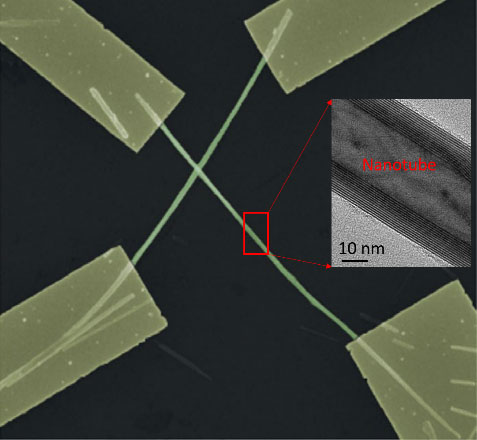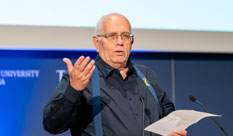More:
News & Stories
Five thousand atoms are all you need: The final piece of the ferroelectricity puzzle
The prestigious scientific journals Nature Electronics and Nature Communications, have reported on the progress made by a joint research team from Israel and China, confirming that a structure with as few as 5000 atoms (10nm in diameter) can still exhibit solid-state ferroelectric effects suitable for production of devices with binary information storage.

Prof. Alla Zak
Nanosized materials, used in the research, provided higher density and more efficient storage devices.
https://doi.org/10.1038/s41467-023-41045-8
https://doi.org/10.1038/s41928-023-01085-w
Ferroelectric effect is a physical phenomenon discovered in the early 20th century by Joseph Valasek. Ferroelectricity is a property of certain materials that creates a spontaneous or induced electric polarization of molecules, resulting in electric field inside the material. The polarization state can be permanent or reversed to opposite direction by the application of an external electric field. Ferroelectric materials in the form of thin films or small crystals can be used for binary information storage and non-volatile (independent of energy source) memories. The size reduction of the individual ferroelectric crystals will increase the amount of the storage units that can be integrated into storage devices, thus providing quicker and more effective performance.
Nanomaterials, prepared in the laboratory of Prof. Alla Zak (Faculty of Sciences, HIT), are semiconductor needle-like crystals ~60-100 nm in diameter (1000 times thinner than human hair) and tens of microns in length, having tubular shape and named nanotubes. Recently, Prof. Yao Guo, China, and Prof. Alla Zak, discovered ferroelectricity in these nanotubes, which allows to build fully operated artificial vision system based on these nanotubes solely (Nature Communications, https://doi.org/10.1038/s41467-023-41045-8). Artificial vision system allows recognition of the subjects using the sequence of actions such as detecting, memorizing and processing. Training of this device was done using machine learning.
In the current study, Prof. Alla Zak, Prof. Guo Yao and collaborating researchers crossed two nanotubes (composed of tungsten disulfide) to create ferroelectric diode at the interface of two nanotubes contact. This reduces even more the size of the ferroelectric device, being ~10 nm in diameter and consists of only about 5000 atoms.
 The electron microscopy image in the figure on the right illustrates such a zero-dimensional (0D) device formed at the interface of two crossed nanotubes. The inset shows zoomed image of the nanotube.
The electron microscopy image in the figure on the right illustrates such a zero-dimensional (0D) device formed at the interface of two crossed nanotubes. The inset shows zoomed image of the nanotube.
Prof. Alla Zak from HIT Holon Institute of Technology and Prof. Guo Yao from Beijing Institute of Technology explained: “Traditional ferroelectric effect is subject to size limitations, because when the size of ferroelectric crystals decreases, depolarization occurs and this can cause the original polarization, essential for ferroelectric effect, to disappear. Notwithstanding, due to the unique properties of the nanotubes and the proposed device design, the smallest (zero-dimensional) ferroelectric diode was successfully constructed, and its proper performance was demonstrated”.
In two groundbreaking articles entitled "Ferroelectricity in zero-dimensional" and "0D Van der Waals interfacial sliding ferroelectricity", experimental evidence and theoretical simulations were provided, which shattered the previously accepted notion that traditional ferroelectric effects were limited by the size of the ferroelectric crystals. With this discovery, the final piece of the ferroelectricity ‘puzzle’ was completed.
The researchers observed resistance changes and hysteresis phenomena typical to ferroelectric material in this nanoscale 0D device, thus demonstrating their ability to perform as a diode. The device produces resistance and photocurrent changes suitable for information storage, while the programmable photovoltaic responses were recorded across almost the entire visible light wavelength range, despite their small size.
"We are surprised that a 5000-atom interface system can produce such rich functionality”, commented Prof. Emeritus Reshef Tenne (Weizmann Institute, Israel), co-author of this study and recipient of the Materials Research Society’s prestigious Von Hippel Prize. Prof. Tenne believes that the downscaled ferroelectricity has important advantages for future high-density information storage, resulting in more efficient and faster performance. Moreover, this research is of great significance for size decrease of other ferroelectric devices such as sonar, fire sensors, and vibration sensors in the future.
Posted: 11/02/2024
- News & Events
New Collaboration with Sheba Medical Center will qualify nurses to work in a digital environment.
Collaboration between HIT Holon Institute of Technology, the teaching authority of the Sheba Medical Center, and the Sheba-BEYOND virtual hospital will allow training nurses in Israel and around the world to work in a digital...



 Additional programs
Additional programs
